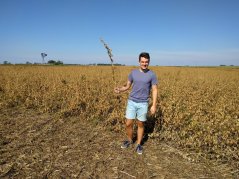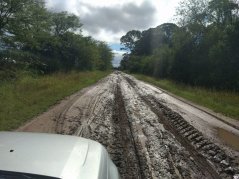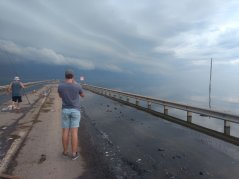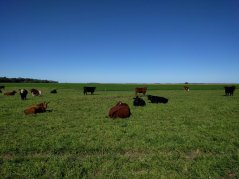Blog post
The wet feet of soy farmers in Argentina
As one of the largest soy bean producers in the world, Argentina is worthy case study to look at the effects of climate change on soy production. Wouter Smolenaars researched the effect of floods on soy bean farmers in his master thesis using climate data analysis and on-site interviews with the farmers.

Argentina is one of the largest soy bean producers in the world, roughly 20% of the world’s total. A natural disaster in the region does not only impact the local farms but also the global market. The Argentinian soy bean farmers are regularly affected by floods, like in 2016/2017 when almost 10% of the Argentinian soy bean production was damaged. This resulted in an increase of the soy prices worldwide. The floods wipe out crops, but more pressingly, they prevent the farmers from harvesting their crops because of the flooded infrastructure. These floods have become more frequent in recent years and can become even more disastrous with climate change. Reason enough for Wouter Smolenaars, of Wageningen University to conduct a research on the impact of climate change on soy bean farmers in part of the Pampas in Argentina and how they can adapt.
Smolenaars has a background in spatial planning and international water management but focused on climate data analysis in his master studies. Because of his personal connection to Argentina, his command of the language and his enthusiasm for data analysis, this project was perfect for him. He combined an analysis of climate data with interviewing local farmers to get to the bottom of the flooding issues of the soy farmers. “Having some connections to the country [Argentina] really helped me to carry out the research, especially the interviews.”

Through his interviews, Smolenaars found that the farmers are mainly affected by the floods in how it limits their transporting capacity. He explains that, “The rural areas are not very densely populated and the infrastructure is not in a very good state, there are mostly dirt roads.” ... “Summer storms and late autumn storms turn dirt roads into mud, horses and SUVs can still cross but not the trucks and heavy equipment”. This means the farmers can still visit their farm, but they cannot plant or harvest their crops even though “in some cases the farmers have to move the produce over many kilometres”.

Smolenaars saw that: “land use change is the main driver of the increased floods. The evaporation and transpiration of soybean cultivation is lower than that of the grasslands native to the studied region. This means more water has to be stored and transported in different ways.” And if this is not managed, it results in floods. This is especially important in the flat areas that are part of Smolenaars’ study region. The extreme flatness means that the excess water cannot flow off overland, and thus fills the soil and floods the lower lying areas.
Flood dynamics are not the same in every region of Argentina. Smolenaars saw that: “The flood vulnerability depends on the region, the soil type and the land use.” In some areas floods result from multiple years of high precipitation filling up the soil above its storage capacity to make it overflow. In other areas floods result from the soil’s inability to take in the vast amount of water generated in one heavy shower.
On top of the effects of land use change, the historical data and the interviews show that both the rainfall events have increased in both intensity and frequency. It is somewhat uncertain what the future will bring, as is always the case when we speak of the future. “Some of the climate models show a high increase and some show business as usual, there is a high uncertainty in the future with a lot of fluctuations.” However, this does not mean Smolenaars thinks we can sit back and just see what will come. He stresses that the problems of flooding are already severe and immediate action is necessary. “There are areas that were suitable for agriculture before but now turned into lakes.”

So then the next question is, how can this project be fixed? Smolenaars sees most in active adaptation: collective action and public action. Now adaptation strategies are mainly local and reactive. “Local adaptation strategies include having a drainage canal, this canal then transports the water to the neighbour and can actually make things worse”. But there are also more promising initiatives. “One of the greatest adaptation strategies I have seen is service crops. A lot of farmers are experimenting with service crops. These are crops with a high evapotranspiration rate. The farmers plant these crops after harvesting the soy beans to increase evaporative capacity of their land. The crops do not generate an income but are an adaptation measure to tackle the core of the problem.” These service crops bring the area back to its old grassy way of dealing with intense rainfall.
These are still very local actions, initiatives by a few farmers, but far from all farmers participate and this raises some issues. “Because a lot of farmers do not own all their land but rent it from landowners, it is harder to implement adaptation measures. If you invest in an evaporation crop or a canal the one year, you are not sure if you will get the same plot the next year.” Smolenaars states that: “They need the government to help them implement and regulate this, otherwise you get free riders. People that do not invest in service crops but they do benefit from the flood reduction.” Additionally, investments in roads and other infrastructure that gets washed away is a government affair.
The vulnerability of the farmers can also be reduced by strategic choices made by them and the Argentinian government. “One of the sub regions I studied is more financially robust because the farmers have mixed land use of crops and cattle. The crops are planted in higher lands and the cattle in the lower lands and during a flood the cattle can be moved to a dry place.” says Smolenaars, “With mixed land use the farmers are less vulnerable financially. However, reducing the soy bean production can have an effect on the international market. For now soy is still the dominant crop because it is the most lucrative but if the flooding continues farmers may be forced to switch crops or move away.” Another way to tackle the economic vulnerability of soy bean farmers is to focus on the full production cycle of soy products. “Instead of shipping out raw soy beans it would also be good to have soy processing factories in the region so the soy products can be sold at a higher price. This can only be done when there is a suitable infrastructure in place for transport and distribution.”

Smolenaars’ research clearly showed that the increasing floods are devastating for the soy bean farmers in Argentina and affecting the soy bean market World Wide. But there is hope, much can be done to reduce floods, reduce flood impact and reduce the economic vulnerability of the farmers. However, this is not a problem that can be tackled by one farmer alone. Increasing the evaporative capacity is most effective when the farmers do this collectively, government action is needed to address the state of the rural infrastructure and investments are needed to be able to focus on the complete production cycle of soy products.
Author: Joreen Merks
References:
W.J. Smolenaars (2018), MSc Thesis: Green gold or risky business, a case study to determine the adaptation turning points for the Argentine soy systems in relation to flood events. Wageningen University and Research, Water Systems and Global Change group
FAO (2017) FAOSTAT data visiualization http://www.fao.org/faostat/en/#data/QC/visualize